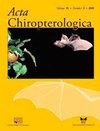婆罗洲鼻总科的细胞遗传学研究揭示了长鼻总科的隐性多样性,并将马来西亚半岛标本分类为新种
IF 0.7
4区 生物学
Q4 ZOOLOGY
引用次数: 2
摘要
应用经典细胞遗传学和分子细胞遗传学方法,对马来西亚婆罗洲犀科一种和水犀亚属三个分类群的核型进行了研究。除四对染色体具有自变形臂组合外,知更草的核型与亲缘关系密切的匍匐茎紫苏相似。在研究的三个Rhinolophus分类群中,只有R.trifoliatus被发现与马来西亚半岛的同种具有相同的核型。相反,来自婆罗洲砂拉越的R.luctus foetidus的核型在Y常染色体易位产物的组成上与来自马来西亚半岛的亲缘关系密切的R.morio不同,后者以前也是R.luctus的亚种。因此,建议将R.l.foetidus提升到特定级别。对婆罗洲2n=45和Neo-X1X2Y性染色体系统的雄性莎草标本的染色体组进行检查,发现与马来西亚半岛2n=28标本的核型存在极大差异,迄今为止也被归类为莎草。因此,以婆罗洲砂拉越为莎草的模式产地,将马来西亚半岛的分类单元描述为一个新物种。本文章由计算机程序翻译,如有差异,请以英文原文为准。
Cytogenetic Investigations in Bornean Rhinolophoidea Revealed Cryptic Diversity in Rhinolophus sedulus Entailing Classification of Peninsular Malaysia Specimens as a New Species
Classical and molecular cytogenetic methods were applied to study the karyotypes of one species of Hipposideridae and three taxa of the Rhinolophidae subgenus Aquias from Malaysian Borneo. Except for four chromosomal pairs with autapomorphic arm combinations, the karyotype of Coelops robinsoni was found to be similar to the closely related Aselliscus stoliczkanus. From the three Rhinolophus taxa studied, only R. trifoliatus was found to share the karyotype with conspecifics from Peninsular Malaysia. In contrast, the karyotype of R. luctus foetidus from Sarawak, Borneo differed in the composition of the Y-autosomal translocation products from the closely related R. morio from Peninsular Malaysia, formerly also a subspecies of R. luctus. Therefore, elevation to specific rank is suggested for R. l. foetidus. Examination of the chromosomal set of male R. sedulus specimens from Borneo with 2n = 45 and a Neo-X1X2Y sex chromosome system revealed extreme differences to the karyotype of specimens from Peninsular Malaysia with 2n = 28, to date also classified as R. sedulus. Therefore, with Sarawak, Borneo, as the type locality for R. sedulus, the taxon from Peninsular Malaysia is here described as a new species.
求助全文
通过发布文献求助,成功后即可免费获取论文全文。
去求助
来源期刊

Acta Chiropterologica
生物-动物学
CiteScore
2.50
自引率
20.00%
发文量
42
审稿时长
>12 weeks
期刊介绍:
Acta Chiropterologica, published by the Museum and Institute of Zoology at the Polish Academy of Sciences, is devoted solely to the study and discussion of bats.
 求助内容:
求助内容: 应助结果提醒方式:
应助结果提醒方式:


